|
Quickly realizing that to sell radios he required local broadcast content was this decision that saw E.S. Rogers convert his 500 watt Ham Station 3BP to the worlds first batteryless broadcasting station 9RB. Station 9RB remains on the air as radio station CFRB in Toronto, short for Canada's First Rogers Batteryless. The new 1000 watt 9RB went on the air from Aurora in January of 1927 on a frequency of 1030 kHz. more 9RB-CFRB history
Ted Rogers Sr. died in 1939 at the young age of 38 from a haemorrhaging ulcer which his son, Ted Rogers Jr. attributed to his fathers non-stop work. In recognition of his tremendous contribution to Broadcasting, Edward Samuel Rogers, Sr. was inducted into the Canadian Association of Broadcasters (CAB) Broadcast Hall of Fame in 1982.
Ted's academic experiences were somewhat like his fathers as his entrepreneurial drive causing him to fail one year of law school at the University of Toronto. By the time he was called to the Bar, Ted had purchased Canada's first FM station as well as an AM station. Today Rogers Communication Inc. (RCI) <http://www.rogers.com> is one of the largest
telecommunications companies in the country, with holding including
Cable TV, Cellular Phone, as well as Local and Long Distance under
Rogers Telecom (formerly Sprint Canada), multi-media, publishing, and 20
radio stations and a television station, CFMT, devoted entirely to
multi-cultural programming. SOURCES: Electron Magazine Chaplin, Maurice Rogers
Communications Inc. You can view the complete Rogers Collection at the Hammond Museum of Radio..
|
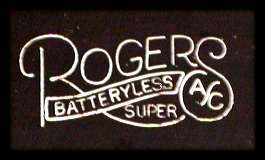

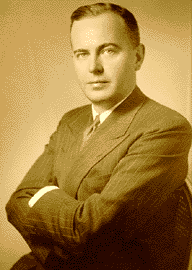
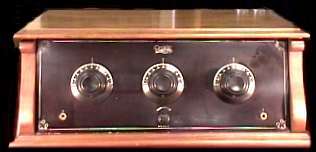 This Rogers Batteryless receiver Model 120 using a 5 tube circuit was
introduced at the Canadian National Exhibition in Toronto, Ontario
Canada in 1925 and sold for $260 including tubes and power supply but
less a loudspeaker.
This Rogers Batteryless receiver Model 120 using a 5 tube circuit was
introduced at the Canadian National Exhibition in Toronto, Ontario
Canada in 1925 and sold for $260 including tubes and power supply but
less a loudspeaker.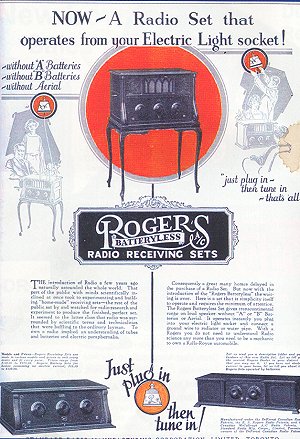 The more
expensive Model 100 was a solid walnut floor console model including a
loudspeaker selling for $370 while the Model 110 was identical except
minus the legs and sold for $335. For the radio listener still not
served by electric power, the Model 100 was made available less power
supply as a Model 105.
The more
expensive Model 100 was a solid walnut floor console model including a
loudspeaker selling for $370 while the Model 110 was identical except
minus the legs and sold for $335. For the radio listener still not
served by electric power, the Model 100 was made available less power
supply as a Model 105. With
the introduction of the AC-30 triode in 1928, Rogers Radio Ltd. became
the Rogers Tube. Co. Ltd. Further change occurred in November of 1928
when a large American radio manufacturer, Grigsby-Grunow, consolidated
its Majestic line with the new company becoming Rogers Majestic. This
merger gave both companies the skills and patents necessary to compete
with other major companies who were beginning to utilize the new
Westinghouse UY-227 tube in their receiver designs.
With
the introduction of the AC-30 triode in 1928, Rogers Radio Ltd. became
the Rogers Tube. Co. Ltd. Further change occurred in November of 1928
when a large American radio manufacturer, Grigsby-Grunow, consolidated
its Majestic line with the new company becoming Rogers Majestic. This
merger gave both companies the skills and patents necessary to compete
with other major companies who were beginning to utilize the new
Westinghouse UY-227 tube in their receiver designs.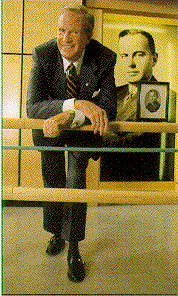
 Ted Jr. was only 5 at the time of his fathers death and remembers seeing
his fathers name on radios being sold at the CNE.
Ted Jr. was only 5 at the time of his fathers death and remembers seeing
his fathers name on radios being sold at the CNE.